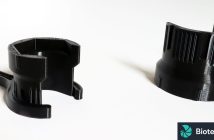
Barreleye Fish
Photos of the “Barreleye” courtesy of MBARI.org
MBARI (© 2004 MBARI)
Sort of an old story, but I found the video associated with it and thought I’d write about it. The deepwater fish is called a “barreleye” (scientifically Macropinna microstoma) and has a see-through, fluid filled head in which it moves its eyeballs.
Researchers at the Monterey Bay Aquarium have released photographs and new information regarding this bizarre looking fish. Discovered in 1939, the “barreleye” was thought to have eyes that were fixed in place, and provided only tunnel-vision. It was also thought that these fish could only look up in relation to their body. However, this all changed when a new paper released by marine biologists Bruce Robison and Kim Reisenbichler indicating that the fish’s eyes could actually move within its head.

Barreleye
Photos of the “Barreleye” courtesy of MBARI.org
MBARI (© 2004 MBARI)
The “barreleye” is a deep water fish that can be found 2,000 to 2,600 feet below the surface, just offshore of Central California. To reach this fish, the scientists used a remotely operated vehicle, or ROV, adorned with multiple bright lights to see in the sunless ocean depths. The researchers were also able to successful catch a barreleye and bring it to the surface alive, a feat never before accomplished. Previous attempts to bring a barreleye to the surface proved unfruitful as the fish would die en route. Once on board, the crew placed the fish into an aquarium where they observed the fish physically moving its eyes, further backing up what they saw on video taken by the ROV.

Barreleye with See-through Head
Photos of the “Barreleye” courtesy of MBARI.org
MBARI (© 2004 MBARI)
The fish’s eyesight is very important, especially when it’s surrounded by complete darkness. At these depths there are also siphonophores (colonial jellies) in the genus Apolemia. While the barreleye doesn’t eat these jellyfish, it is speculated that the barreleye eats food that they jelly catches. These siphonophores capture small crustaceans called copepods, as well as other small creatures living at that depth. Since the jellies don’t move very fast or digest food very quickly, their meal can easily become the meal of others, like the barreleye for example. It is also assumed that since the fish’s eyes are so sensitive and so important to its survival, they are hidden away in a protective and transparent shield. When the barreleye come into contact with the siphonophores, it is doing so face first, thereby jeopardizing its eyes. The shield keeps the sting cells of the jelly out of this barreleye’s eyes.

Siphonophore Jelly
Permissions and Sources:
MBARI.org
MBARI (© 2004 MBARI)






Pingback: Strangest fish I have seen so far,()
Pingback: Cool new fish I added to our office display aquarium, rare fish lovers check it out!()